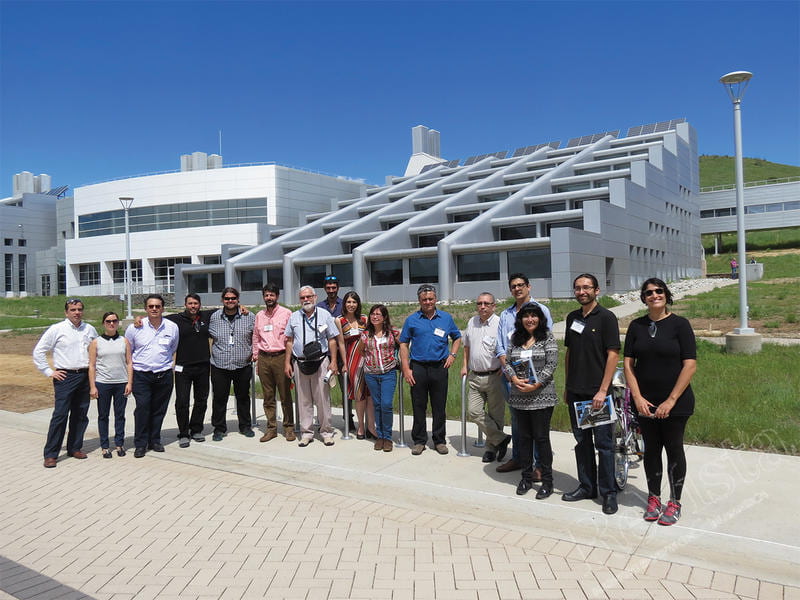Solar Energy in Chile
Development and Challenges

The chilean group met with NREL researchers in Denver, Sandia in Alburquerque and the University of Arizona in Tucson and explored the latest technological developments. Photo courtesy of SERC/Claudio Agostini.
For several decades, Chile has struggled to have a stable and reliable mix of energy sources to satisfy its growing needs. In the 1980s, the country relied heavily on hydroelectricity, considered almost the sole solution to its growing energy requirements. As a result, every time the country faced a drought, there were even periods of blackouts and rationing because not enough energy was being produced.
In the mid-1990s, a combination of continued rapid growth in energy demand, increasing environmental concerns regarding large hydro projects, and the unreliability of hydropower prompted the Chilean government to diversify energy sources by encouraging the use of low-price natural gas from Argentina. The low-cost energy from the imported natural gas made it more attractive to build combined-cycle power plants instead of relying on large hydro plants and coal. Thus the energy sector invested heavily in this source, building four pipelines from Argentina, setting up new gas distribution networks and constructing a half a dozen new combined-cycle power plants. In 2004, natural gas accounted for 26% of Chile’s total energy consumption, of which 80-90% came from gas supplied from Argentina. As a result, in 2004 the Argentine government restricted the volume of gas exports to Chile in order to relieve its own domestic gas shortages. In just a few years, the gas supply to Chile stopped. This brought about another energy crisis in which generators were forced to replace gas-fired electricity with expensive and more polluting diesel generation, and the government promoted the construction of liquefied natural gas (LNG) terminals to compensate for these changes and have another alternative to Argentine gas.
The successive energy crises have taught us a valuable lesson. The country is now more concerned with energy diversification, understanding its important role for the security of the system. The country has learned that short-term gains come at a high long-term cost. In addition, the economy’s dynamism over the last decades, including the significant improvement in the welfare of the population (poverty, for example, has decreased from 40% to 13% in two decades), has doubled electricity demand. Chile is now the country with the highest energy consumption per capita in Latin America, well ahead of larger countries like Argentina, Brazil and Colombia.
Chile is also considered one of the most attractive countries for the development and deployment of renewable energy technologies (RET), mostly because its geographic location and diversity provide abundant renewable energy resources (RES). Significant potential exists in the use of biomass, hydropower, geothermal, solar, wave and wind energy. In particular, Chile has one of the largest solar potentials in the world. With almost 356 days of clear skies, high solar radiation and low humidity, the Atacama Desert in northern Chile offers excellent conditions for generating solar energy. Therefore, adding solar energy to the energy mix can be an important opportunity to contribute to the country’s energy diversification strategy.
To attract renewable energy investment, several new regulatory incentives have been introduced. In 2008, the Chilean government took a significant first step forward by requiring energy-generating companies to include at least 5% of their electricity from non-conventional renewable energy sources by 2010, without including large hydro (only up to 20 MW). This quota of renewable energy set a 5% target from 2010 until 2014 as the transition period, with 0.5% increments from 2015 through 2024, when generators are expected to produce 10% of power generated through renewable sources. If companies do not comply with the quota, they have to pay a fine, which doubles if the incompliance occurs again.
Although the fines are in some cases cheaper than the cost of compliance, the policy has been quite successful, and energy generation from RES has met or even surpassed the defined quota of 5%. Renewable energy generation reached 7% of the country’s total energy generation in 2012. Until early 2012, small hydro and biomass were the leading renewable technologies used for the compliance of the legal quota, accounting for almost 90% of total renewable generation. However, during the last couple of years, other renewable technologies, including solar and wind, have started to play a more significant role.
In 2013, the Chilean government increased the quota by doubling its renewable-energy target from the previous goal of 10% by 2024 to 20% by 2025. Even though this new target provides attractive incentives to invest in the development of renewable energy projects, the amount of investment in new capacity required to reach the 20/25 target is quite significant. In fact, the new renewable energy capacity that should be added to the current energy matrix in the next 10 years to reach the target is much higher than the average annual renewable capacity that entered the matrix during the last five years. Additionally, to reach the renewable energy target of 20% by 2025, electricity grids will have to be upgraded and expanded.
Investors in renewable energies in Chile also face significant challenges. Although the Chilean government has shown interest in promoting the development of RES, a number of obstacles remain, resulting in a moratorium on several projects. Most of these projects are wind and solar technologies, with only around 10% in terms of capacity realized thus far, despite having environmental approval.
The most important barriers that renewable energy projects face in Chile are the high cost of the initial investment, limited access to financing, opposition from local communities, the practical and regulatory difficulties to connect to the grid, and lack of interest from large consumers to sign long-term contracts with intermittent sources (solar energy is produced only during the day and wind energy is produced only when there is enough wind blowing; solar and wind have plant factors of 30% or 40% at most). Removing or at least mitigating these barriers and creating further incentives remains a key challenge for the development of the Chilean renewable energy sector.
The evidence increasingly supports that solar energy has great potential to become a major source of clean and secure energy in Chile. In addition to overcoming the hurdles facing many renewable energy projects, both misconceptions about solar energy and some of its unexpected benefits must be explained.
Even as the costs of solar power continue to decline, the public and many policymakers perceive solar energy as “too expensive”—thinking that solar energy would lead to increased energy prices. However, solar panel prices per watt generated have decreased 86% between 1996 and 2013 because of significant technological advances. The costs, therefore, are becoming increasingly competitive with respect to other technologies. If pollution caused by the use of fossil fuels such as coal and diesel were figured into the costs through the implementation of corrective taxes, solar energy cost would become even more competitive.
Although solar power’s most obvious benefit is the environmental advantage from producing less CO2 emissions than fossil-fuel-burning technologies, the use of solar energy has a potentially large social value that is missed by traditional cost-benefit analysis. Solar energy can strengthen the economy in rural areas because network extension of traditional energy systems is typically not a viable economic option for these communities. In isolated rural areas with lack of access to electricity, grid extensions are often not cost effective. Therefore, isolated, or off-grid, small solar energy systems can provide a sustainable and cost-effective alternative to the diesel based solutions that are typically deployed in such areas. Chile has more than 3,500 isolated rural communities with no access to energy networks, many of them lacking access to roads and infrastructure to maintain the flow of fossil fuels.
Solar energy has now started to play a greater role in the energy matrix of the country. There are still some problems that need to be overcome to allow the full deployment of its large potential, but a future with cleaner energy and sustainable development is becoming increasingly feasible.
Achieving the ambitious renewable energy goals and overcoming existing barriers require strong, consistent and balanced policy support by the government. Unless the Chilean government takes a leadership role establishing prioritized areas of policy interventions to address challenges rapidly and properly, it could miss a chance to materialize large-scale solar development and to recoup the benefits of solar energy investments for the development of its communities and regions’ economic growth. Establishing a policy framework to accelerate market competitiveness, supporting the needed confidence for investments in local technology advancement and manufacturing capacity, facilitating large-scale solar grid integration, implementing new financing and business models, expanding international collaboration to provide accelerated learning and knowledge transfer to Chile, and improving training, education and awareness for solar energy technologies are among the priority policy actions to be taken shortly.
Fall 2015, Volume XV, Number 1
Claudio A. Agostini is a professor at the School of Government, Universidad Adolfo Ibáñez, Santiago, Chile.
Carlos Silva is a professor at the School of Engineering and Sciences, Universidad Adolfo Ibáñez, Santiago, Chile.
Shahriyar Nasirov is a professor at the School of Engineering and Sciences, Universidad Adolfo Ibáñez, Santiago, Chile. The article is based on previous research by the authors, who are grateful for the financial support of the project CONICYT/FONDAP 15110019.
Related Articles
Oil and Indigenous Communities
On a drizzly morning in late February, a boat full of silent Kukama men motored slowly into the flooded forest off the Marañón River in northern Peru. Cutting the…
Mexico’s Energy Reform
The small, white-washed classroom at the University in Minatitlán, Veracruz, was packed with a couple dozen people who, although neighbors, had never met…
Geothermal Energy in Central America
When we think about global technology leaders, Central America does not typically come to mind. But Central American countries have indeed been in the…




